On a recent coastal walk here on the South Shore of Nova Scotia, we came across this interesting rock. It lies among other boulders and looks as if it has been here for a very long time. But has it, is it an ancient petroglyph or is it a modern carving, done by someone having a bit of fun?
The carved scene is complicated and looks like St George and the Dragon, or some sea serpent, with a knight and horse. So, who carved this horse on the stone? Or the knight who has just killed the dragon?
The Mi’kmaq recorded images of people, animals, hunting and fishing. With the arrival of the Europeans, they began to include images of sailing ships, men hunting with muskets, soldiers, Christian altars and churches, and small items like coins and jack-knives.
Can anyone solve this mystery for me? Is this a modern day carving or is it an ancient stone, with a meaning? There are many theories, but I’m sure there is a simple explanation.
At least this post has attracted a lot of interest and differing views.
Update – January 24th, 2017
In 2013, the Curator of Archaeology at the Nova Scotia Museum said it had been carved with a metal tool, so was probably done by a local artist.
Then the Director of Studies in History at Yale University said it was a clumsy copy of the Ramsund Carving.
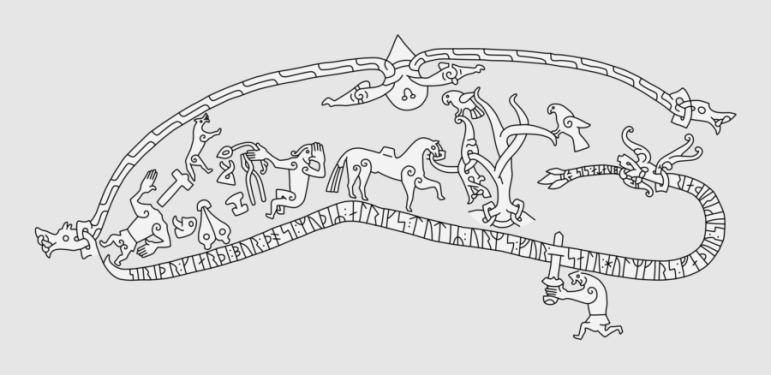
It really is very much a copy of this!
Three men were committed to creating this wonderful original which took them 7 days to complete.
The process used in creating this masterpiece is still a puzzle except that heat was used before the carving was carried out. No chisels were used.
At the period of carving the stone was further inland. However, due to environmental changes, erosion of the coast, the stone was finally situated on the beach. Much of the erosion was caused by ice pushing up against the cliffs in winter periods during the small ice age which finally ended in the late 1800s.
The stone is currently buried to a depth beneath the beach of nearly 3 metres. In other words there is more stone beneath the beach than above it.
There are 6 ley lines ( earth energy lines) crossing the centre of the stone. All are positive- some male others female.]
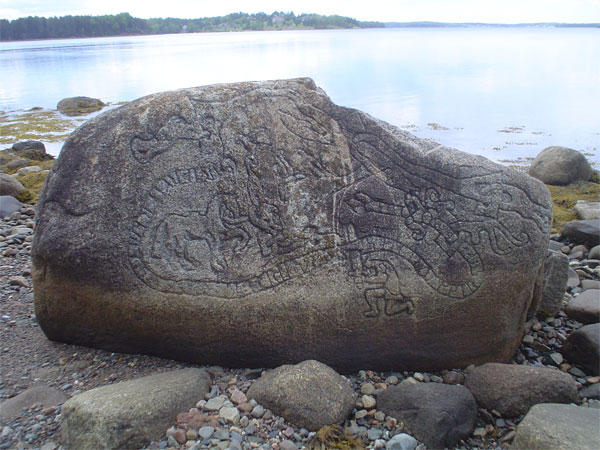
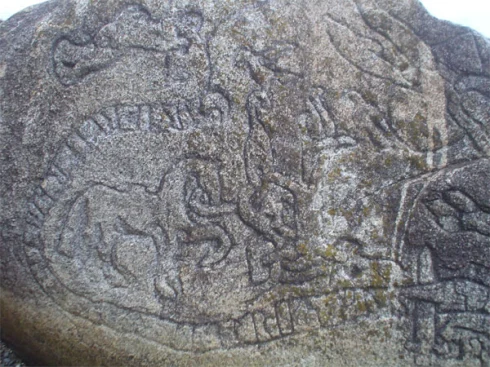
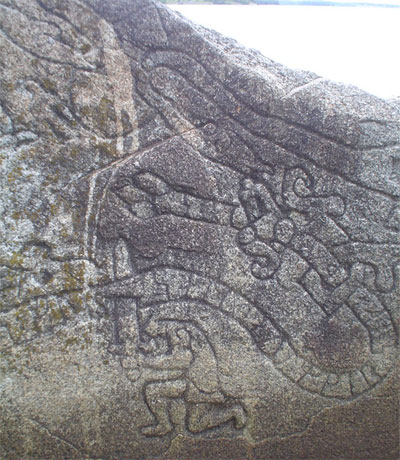
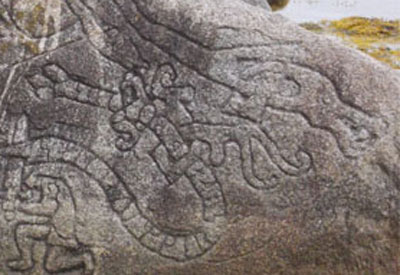

Hey Jackie, send your photos to the Nova Scotia Museum. I once sent them an image of a carved rock I’d found at Polly’s Cove and they were able to tell me a bit about it. I bet they’d love to see your shots.
How did you find the rock ?
Thanks, Sybil, I’ll try them and see if they know about it. Maybe just someone from one of the cottages, marking a boundary, or trying to confuse people like me. We just found it as we walked the shore at Second Peninsula – we had walked past it many times, before we spotted it.
Forgot to tell you that I know where the Bedford Petroglyphs are. Went there and couldn’t see the darn images. Pretty faint …
Just curious – did you ever get any more information on the origins of this stone carving? The “markings” inside the serpent’s body look like Norse runic symbols, so if this was someone modern going to the trouble of carving it out to look “old” they did a rather fantastic job of it.
Hi Patrick,
I did write to the Nova Scotia Museum and got this reply.
[Thank you for sending the photo of the carved rock at Second Peninsula. I have seen this one before. Based on the style of the design and the fact that it was produced with a metal tool I would say that it is modern, and likely produce by a local artist. Perhaps as you say, just someone having a bit of fun.
Cheers,
Steve Powell
Assistant Curator, Archaeology
Nova Scotia Museum]
I wish we knew who carved it. As you said, someone took a lot of trouble with it. Have you seen it?
Jackie
I’m glad I came back and saw the follow up on the carving, Jackie. How about take a pic of it and sending it to your local paper, to see if anyone knows its story. It really is lovely.
Hello,
may be make some photos of the runic writings on the stone and send it to the royal academy of stockholm, sweden or natinal museum of Norway, Oslo. there are runic/old norse language specialists. Surely they can tell You if the inscriptions are in Oldnorse or of newer age. Motives like on that stone are similar on runestones in northern europe. You can compare here: http://www.arild-hauge.com/sweden.htm,
Ben, Germany
p.s. the carved motive seems to be out of an old norse/german tale about sigurd/siegfried who killed the dragon to get the gold of the rhine (river). Great middleage poem called the “Nibelungen Not” in german. Nice retold by Stephan Grundy “The Rhinegold” 🙂
Ben
Following up here … I have spoken (somewhat) recently with Anders Winroth, the Director of Graduate Studies in History at Yale and a well-published Norse expert, and he made the following observation in his response:
“This looks like a somewhat clumsy copy (surely modern) of (parts of) the famous inscription on a Swedish rock face known as Sö 101, see http://en.wikipedia.org/wiki/Sigurd_stones#S.C3.B6_101.”
So, while likely a 20th century creation, it still is a fascinating little art project that someone took the time to undertake in a pretty remote region of coastal Nova Scotia.
I’ve spoken with the editor and Lunenburg reporter for the Progress Bulletin (the local newspaper). They were previously unaware of the stone’s existence and are equally curious as to who created it and why.
Sorry, Patrick, I’ve just seen your comment. Wow – it couldn’t look much more like the link you sent! So, we know what it is, now it would be good to know who the clever person is who carved it.
Hi I am a mason from halifax and may have a theory on who carved that stone. Where the stone appears to be granite, the artist would require special chisels which are quite costly and hard to come by for the average joe. i know of a family who runs a granite quarry in new germany which is not far from there, they would have the proper tools for the job and are from I believe Sweden to boot. I may be way off but you may want to talk to a lad named Tobias Laing. or Lang?
Thanks for reading my post and taking the time to reply. What you say is very interesting. I see that the owners of the quarry are Lange, but can’t find a Tobias. I have written to the local paper to see if they will publish a photo of this stone and help find the carver.
im tobias lange. but i didnt carve this one. mine are hidden elsewhere.
knights Templar … oak island … treasure map
This is very interesting. If I had to say I would reflect to the legend of Sir Henry Sinclair, the Earl of Orkney who had voyage with about 300 other Templar’s to the “New World” in 1395. Legend say’s that they had landed in Nova Scotia. Where exactly does this stone sit on the south shores of Ludenburg?
I don’t think it has anything to do with Oak Island or the Knights Templar. The comment by Patrick Hirtle is the best so far. The link he gives, shows the Ramsund Carving from Sweden and the stone I found is almost an exact copy.
http://en.wikipedia.org/wiki/Sigurd_stones#S.C3.B6_101
We just need to know now who carved it.
Where exactly is this stone? Is it still on the beach in the same location? I’d like to go look at it. 🙂 And have you learned anything further about it?
Hi, It’s on the Mahone Bay side of Second Peninsula. If you go along Prince’s Inlet Road to Young’s Lane, then walk along the beach at low tide, you will find it along there. The best information I have been given was the similarity to the Ramsund Carving. I am sure this is just a modern copy of that carving.
Greetings Jackie Queen :
My name is John Wolcott. I live in Albany , New York but have
worked and travelled in Nova Scotia further north of you. I visitd
Lunenburg in 1964 but only with some of work crew for an afternoon
I also once spent time in the Yarmouth area wher I looked at the
” Yarmouth Rune Stone which looked fade to me.
there. I’ve also travelled in Greenland where I’ve spent some
amount of time among the Norse Ruins at Hvalsey and Gardar,
and Hvatnaverfi. Since I do have an interest in the subject I
lucked out many years ago and was able to purchase my own
copy of ” Runic Monuments of Scandinavian and England by
Dr. George Stevens, Copenhagen 1884. I’ll see if the stone
you refer to as being similiear in in it. The Photos you have
are truly asounding and can’t beleive that there isn’t more
going around about your find even by way of a contraversy.
The stone is obviously Old Norse in form and the inscriptions
r
are runic in shape. But I would not venture any opinio
as to wether they are fake or authentic without looking at in
person . I want to spend some time visiting the Kejimikujik
Petro’glyps soeitme and now am interested in posibily taking
a side trip from ther to see your stone .
It’s hard to tell form the photos just how much westhering the
inscription has or if it’s apparent that the carving was made a few
years ago. Off hand though I’d think it would be well water worn
if it had been under water for centers.. Of course an origianl or
a fake would have been incised with a metal tool, but who would
have the time or expertise among an exploring and or trading crew
carve something like that on a trip like that would have been ?
I don’t know but there are many things to consider in this. It’s
most Norse looking sone in North America or Norse America and
it must have been carved either centuries ago by a professional rune
carver or by a contemporary highly skilled forger known as the
The Halifax Chisler “. Perhaps the stone shold be secured in
a protictive safe place just in case, after the poistion in which you
found has been fully recoreed and documented.
Very truly,
John Wolcott
Look at the meaning to the original “Sigurd Carving”. The meaning behind the carving is the story of “Sigurd” defeating “Fafnir” and on request of “Regin” had roasted “Fifnir’s heart. During the roasting “Sigurd” had burnt his fingers and placed them in his mouth with the residue from “Fafnir” heart on his hands. After he had tasted the blood of “Fafnir”, “Sigurd” started to understand what the birds were saying and they had warned “Sigurd” of “Regins” treachery and on that “Sigurd” had slain “Regin”. The runic lettering on “Fafnir” tells of ones accomplishments in life. These are “Memorial Markers”, created after the death of someone. Meaning they, too have learned the “Divine Language of the Birds” or “Language of the Angels”. Their name and accomplishments would have been written within the body of “Fafnir”. What you have is a memorial to an “unknown person or group” with a “noteworthy unknown task”.
Hey there, I recently found this rock, not that easy and I can tell you that it’s runes are similar in nature to the Swedish Sigurd carving but some of the runes are clearly arranged in a different series than the Swedish Sigurd carving. Would you be able to tell me more about these ‘Memorial Markers’ and how you came to learn of them. Are you close to Halifax, N.S. ?
I don’t know anything about Memorial Markers, I just tried to discover who carved this stone.
Hello, I am sorry to say that I am not from Nova Scotia but rather from Kalamazoo Michigan, USA. I am a Oak Island theorist researching the Templar Knights coming to Nova Scotia pre 15th century. What would you like to know?
what Anders Winroth, the Director of Graduate Studies in History at Yale and a well-published Norse expert said is that the stone was not carved by the original artist of the Ramsund Carving. As for the identification of the time period, I would like to know his reasoning for it being with in the 20th century. What are the determining factors besides it being brought up now.
So why do you suppose the left side of the Sigurd Carving is missing from this rock? It’s the left half that describes much of the Norse Mythology you described. In this one it only depicts the horse, the dragon/serpent and a tree that should be in the middle with a bird on top, but I can’t quite make it out. But, in any event, this one doesn’t appear to be telling the same story as the Sigurd carving but the uncanny resemblance can’t be a coincidence. How does one date a rock carving anyway??? 🙂 I intend to take a day trip soon to go look at it myself. I think it’s fascinating, even if it was done by a local artist some time in recent history.
It’s not about missing a piece of the whole. It’s about it being there in the first place. Do you want to know the answer? It’s a second marker……it’s onething to have a starting point but you also need a finish point. If I gave you the shape of a island isn’t just as important to know where the island is? Do you realize that there is a map to all this?
I do… Saw it immediately. LOL
No, i’m serious….there is a stone in the States that is the starting point and there was a map used in a book that the author had found in a collection of maps. The author had no idea what it was a map to but must have thought it would add to his book. The map is of the island and written on it dirrections. The funny thing is that the perimeter shape of the island matches one of the islands in Mahone Bay. Sir Henry Sinclair said his last voyage was to retrace the footsteps of his ancestors the Vikings. So I would assume he would follow many examples of the Vikings. So, if some great task was done I would exspect it to be marked with a stone like that.
If you look at the carving closely the figure if Sigurd has a cross on his back. This is also not far from the New Ross Castle or Roslin.
http://norumbegavinland.wordpress.com/
Macnova2013,
Thank you for pointing out the “Cross” on the back of the “knight”. I did not see that little feature. How many knight carried the symbol of the cross? I can only think of one, and having both “Christian Symbols” and “Viking Runic Symbols” thell me this stone was created after the Vikings voyages to the new world. Why create this stone with the “Cristian” symbol? I would still say Templar Marker…..Has any of you seen the templar cross carved on a stone on the southwest end of Nova Scotia? I’m telling you folks it’s the marker which signifies the location to a “Island”. A island that was drawn by the Zeno brothers and the details filled in by Sir Henry Sinclair. A drawing that was later found by Harold Wilkins in the early 1900’s at the British Museum. He added feature to give it realism to aid in the sale of his book.
Why did you copy my photos and say this stone was covered in moss and sea gull droppings? I don’t think you have been anywhere near this stone!
That’s really interesting Bob, can you share a link that talks about that aspect? When I first saw the rock carving shown here, I immediately thought the outline looked alot like Oak Island, that’s what I thought you were referring to as well, but what you’re saying is another angle altogether that I’d like to read more about. Thanks. 🙂
The answers that I am telling you are based on my own research. Yes, it is of Oak Island and I have share some of this with the current investors of the”Money Pit”. I believe the hardest thing to do is get people to listen. Do you want to see a good example of the Templar’s in Nova Scotia? Look in Overton, there is another stone carving but it is a good representation of native indian/ Templar pictogram. It is the native indian symbol for Earth and its 4 points, North, South, East, West. The Circle with the cross is native indian symbol fo Earth but it has the Templar cross in it. Another oddity is in one of the tales of “Glooscap” one of his friends happen to have blue eyes and facial hair. Glooscap also taught them the game of I believe what is called Lacrosse. But you have to look at the game the Scotish played that dates back before christianity. It was called “Shinty”, and was a form of “field hockey”.
Hi Jackie,
Can you Email me at deveau at chebucto.ns.ca please?
I would like to clear-up some confusion about this stone.
Regards,
Terry J. Deveau
Please share it publicly too! I’m fascinated by the carving and all of the mysteries cropping up out of my neighbouring Province: Oak Island, Mystery Walls, all kinds of goodies. I think you may want to consider that the age of these things are potentially much, much older than centuries. Maybe alter your perspective and add a couple zero’s? 🙂 When things don’t add up, usually that means there is a false assumption in the equation. Question those assumptions and see where it leads! No harm in thinking outside the box, right?
Have we heard anything further on the date of this stone?
THe stone contains a jumble of different elements that don’t belong together. North America is full of stones like this mostly made by immigrants to either amuse, mislead or make money. In the late 1800 s schoolchildren in Scandinavia all learned basic runes. And many Swedish and Norwegian stoneworkers found work here in the haydays of the stone industry 1890-1910. Exposure to saltwater and weather may help a stone like this look more weathered and older than it actually is. I would be cautious reading too much into this stone. The Overton stone to me looks more authentic , although the cross may have been added later. It is likely by another “artist”.
I would love to see this stone. We walked the shoreline a few weeks ago and were unable to find it. How far down the beach is it from Youngs Lane
It is remarkably similiar to a tune stone found in Sweden in the 1800s; Both tell the story of Sigurd who slays a dragon with a manically sword he has had reformed. The stone you saw on the beach was carved by someone with knowledge of the Swdish rune stone as it is very similiar. Google Norse stone carvings and you will see it.
Yes, Patrick Hirtle said much the same thing and referred us to https://en.m.wikipedia.org/wiki/Sigurd_stones#S.C3.B6_101. I think it seems to be a copy of that.
Do you have Latitude & Longitude for this rock?
No.
Hi Mr. and Mrs. Queen,
I’m writing an e-book on the Oak Island mystery for the site MysteriesOfCanada.com and was wondering if you might allow me to use your photo of the South Shore stone (with attribution, of course). If that would be alright, please let me know.
All the best,
Hammerson Peters
I’d be pleased if you could find out anything else about this.
Received this report from a friend who is a dowser and looked at the stone for me.
————————-
The runestone is genuine and was created in 1167 during the month of October.
Three men were committed to creating this wonderful original which took them 7 days to complete.
The process used in creating this masterpiece is still a puzzle except that heat was used before the caring as carried out. no chisels were used.
At the period of carving the stone was further inland. However, due to environmental changes, erosion of the coast, the stone was finally situated on the beach. Much of the erosion was caused by ice pushing up against the cliffs in winter periods during the small ice age which finally ended in the late 1800s.
The stone is currently buried to a depth beneath the beach of nearly 3 metres. In other words there is more stone beneath the beach than above it.
There are 6 ley lines ( earth energy lines) crossing the centre of the stone. All are positive- some male others female.
I really suggest you look into the stories of “Enoch” from the Bible. He had something in common with “Sigurd”. They both spoke the language of the Birds or language of the angels. It was the Angel “Uriel” who had taken Enoch to where heaven and earth end and shown a “Great Abyss” …(To the West) and he was referring to “Purgatory”. You see “Sigurd” was shown favor by “Odin” as “Enoch” was shown favored by God. Enoch never experienced death, God had take Enoch to heaven and had given him the gift of speaking the secret language of the Angels. Enoch was believed to be the true right hand of God and he was believed to be the person who designed the pyramids of Giza and he had the gift of proficy, look at the back of a US dollar…Freemasons don’t speak a secret language but rather a language in secret…If “Hirahm Abiff” was the grand builder then took at the meaning of his name…”Hirahm” meaning “exalted brother” and “Abiff” meaning “My Father”. In the story of Enoch, Enoch had designed a underground vaults consisting of nine, one on top of the other and the entrance to each vault was through the arch. It was Enoch’s son who had built it as he had built the Pyramids. His name was Methuselah. He was the true “Grand Builder” and “Enoch was the Exalted Brother.
Actually, Rosslyn Chapel has the answer to this stone and it’s quite clever…..
Look at the West side of Rosslyn Chapel, You will see a round window with a cross in it. It resembles the carving on the Overton Stone, of the Circle with a cross in it.
Notice the depiction on the Norumbega Vinland stone, The depiction of the Norse legend of Sirgurd defeating Fafnir, but with a twist….Sigurd is wearing a “Cross”, depicting Christianity… Look at the “Green Man” in Rosslyn Chapel, one of the beliefs of the “Green Man” is that it’s representation of the Bridge between old and new “beliefs”. Just as Rosslyn Chappel is the link between Templar/Freemason. These Stone’s in Nova Scotia are the true “Shepherd of Arcadia”.
What does that mean?
There are some who believe in the idea that Sir Henry Sinclair came to the “New World”, but why would he had come? Contemplate the idea that the Templar knights had found the “Religious artifacts” that once was held within the “Holy of Holy’s” on the Temple mound. Those artifacts were considered “Gifts” from God. Look at the “Overton Stone”, the
Tobacco and Eagle feather carved into the stone were considered “Gifts from the Gods” by the “First Nation”. Look at the “Norumbega Vinland Stone”, the depiction of Sirgurd slaying Fafnir of Norse legend, what people fail to realize is that Sigurd also received a gift that only the God “Odin” possessed and that was the ability to speak the language of the birds. Also known as the Language of the angels or the “Green Language”.
HI.
i just read your posts on Jan. 23, 2017, and I’m wondering if your blog is still being maintained. None of the posts show a year. If you are, I would appreciate knowing how recent the posts are.
Thanks.
Steve
Hello, Do you mean this post in particular? It was written in 2012 and you will see that there have been a lot of comments over the years. I replied in the comments in August 2016, when a friend gave me his belief after dowsing the area.
All the comments are dated.
Not sure if this link has been posted.
https://thecrowsfjord.com/2018/06/03/ramsund-copycat-in-nova-scotia/
https://en.wikipedia.org/wiki/V%C3%B6lsunga_saga Found this researching the Helm of Awe and Nordic History that led me to the stone in Sweden, depicting the Volsunga Saga. Cheers
Yes, thanks, I had added a bit to my post that showed the same carving. It is definitely a copy of the Volsunga Saga
It’s a Runestone.. Scandinavian in origin. Could be a forgery, but if not then Norse explorers from Greenland and maybe Iceland were involved in its creation as they explored, even discovered these lands a thousand years ago..
It’s definitely a depiction of Sigurd slaying the dragon Fafnir and is practically identical to other Sigurd stones found thru out Scandinavia and various UK viking colonies, Vikings carved with metal tools as well I think the local museum and so called experts are way too quick to dismiss the Lunenburg stone as modern. I suspect it is linked to new Ross castle, and the Overton stone in Yarmouth somehow.